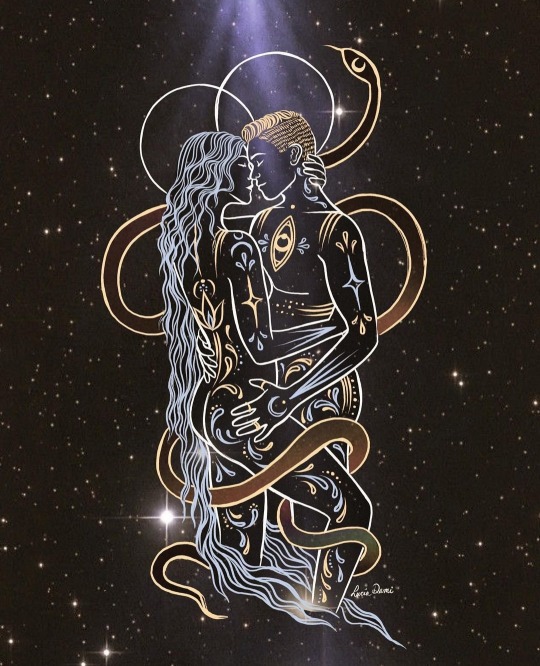Text


Yab-Yum
Wisdom and compassion can become one.
What is Yab-Yum?
Yab-yum is a symbolic representation of the union between a male deity (yab) and a female deity (yum). The term itself originates from Tibet, where the word "yab" represents the masculine aspect, often referred to as the Father associated with wisdom and compassion, and "yum" represents the divine feminine, embodying the role of the Mother often associated with bliss and emptiness.
In artistic depictions, yab-yum is represented by a male deity in a seated position, often portrayed as a peaceful and enlightened Buddha or a deity like Vajrasattva, and a female deity sitting or standing in the lap of the male deity, embracing him. The female deity is often portrayed as a compassionate figure, such as the goddess Tara or the consort of the male deity.
The Spiritual Symbolism of Yab-Yum
An iconic image associated with tantra, the yab-yum position holds significant prominence within both Hindu and Buddhist tantric art. The posture transcends the boundaries of conventional human sexuality and delves into a realm of divine and cosmic union. At its core, the image embodies the concept of duality, therefore represented through the masculine and feminine union but gives direction towards a state of non-duality, or Advaita, where the illusion of separation dissolves, and a profound unity is experienced. It represents the profound understanding that existence arises from the interplay of opposites and that the ultimate reality encompasses both the manifest and the formless.
The yab-yum position signifies the merging and harmonizing of opposing forces. It represents the balance and integration of polarities within oneself and the universe. The masculine and feminine energies are seen as complementary aspects that together form a complete whole. In essence, the yab-yum symbolizes the union of wisdom and compassion, form and formlessness, masculine and feminine, and represents the inherent unity and interconnectedness of all things in the tantric worldview.
The fundamental concept of 'Advaita,' or non-duality within Yab-Yum
In Sanskrit, the term, advaita means non-duality. It is also a concept commonly associated with Advaita Vedanta but equally relevant in the profound teachings of tantra. To understand the concept of Advaita, one must carefully deconstruct the linguistic implication of the term Advaita or its English translation 'not-two-ness.' Here the words do not suggest becoming one or infusion; it does not imply a merging into homogeneity. Instead, it represents a state where separation, division, and the illusion of individual identity cease to exist while the diverse elements retain their inherent nature. It is a state of neither loss nor acquisition.
This understanding eludes the grasp of the rational mind, which can only comprehend the world in terms of singularity or plurality. Therefore, the yab-yum depiction of the union of a male and female deity highlights the fundamental principle that the apparent duality between self and other, subject and object, is illusory. It alludes to the understanding that the true nature of reality transcends dualistic distinctions signifying the inseparability and interdependence of the masculine and feminine energies, symbolizing the dissolution of all dualities but not infusing into a singularity.
Vajrasattva and his consort in Yab-Yum
Vajrasattva is the embodiment of purity and compassion and, in his solitary form, is a familiar subject in Buddhist art. However, although less frequently, Vajrasattva is depicted with his consort in the yab-yum posture, alluding to a profound father-mother aspect of Vajrasattva. In the Yab-Yum depiction, he is joined by his consort, Vajratopa or Vajragarvi. The consort is often depicted holding a Kartika in her right hand and a kapala in her left, symbolizing the transformative and nurturing aspects of the feminine principle. Mahayana Pilgrim
24 notes
·
View notes
Text


"Love is the ultimate truth at the heart of the universe and transcends all boundaries." ~ Deepak Chopra Art by Muhammed Salah
102 notes
·
View notes
Text

Sexual Energy
“Our erotic nature is the seat of your life-force and power.
It vibrates with aliveness, turn-on and connection, both sexually and non-sexually.”
Harnessing your sexual energy opens a realm of possibility. When fully released, it is more than an orgasmic experience- it reawakens the soul and reconnects us with our true power. It can be healing for emotional traumas as we explore ourselves on a deeper level; allowing physical pleasure to take center stage alongside mental clarity gives rise to liberating visions that help enhance creativity.
“In the house of lovers, the music never stops, the walls are made of songs, and the floor dances.” --Rumi
‘Midnight Sonata’ Relm relmartist
424 notes
·
View notes
Text

When we learn to master our sexual energy, this powerful force can be a catalyst for spiritual growth. Sex is a sacred act. The level of physical, emotional, and spiritual bliss that can be experienced is dependent upon the level of consciousness and awareness which we bring to the act.
96 notes
·
View notes
Text

每日雙修,雖然平常沒感覺到什麼變化,但偶爾有一天,你會突然發現那寧靜的力量已經大大你的改變身心與智。
2 notes
·
View notes
Text

如果自己假借雙修找爽,再怎麼玩都會不夠爽,只是銷毀自己的身體而已。
但有智慧的雙修找安心之道,再多的交合反而更讓身體精煉輕盈,沐浴在神秘的生命之風之下,不張狂,靜靜做自己。
2 notes
·
View notes









